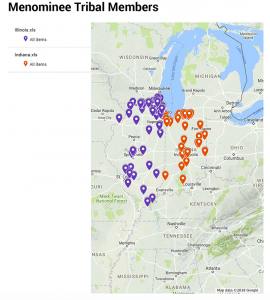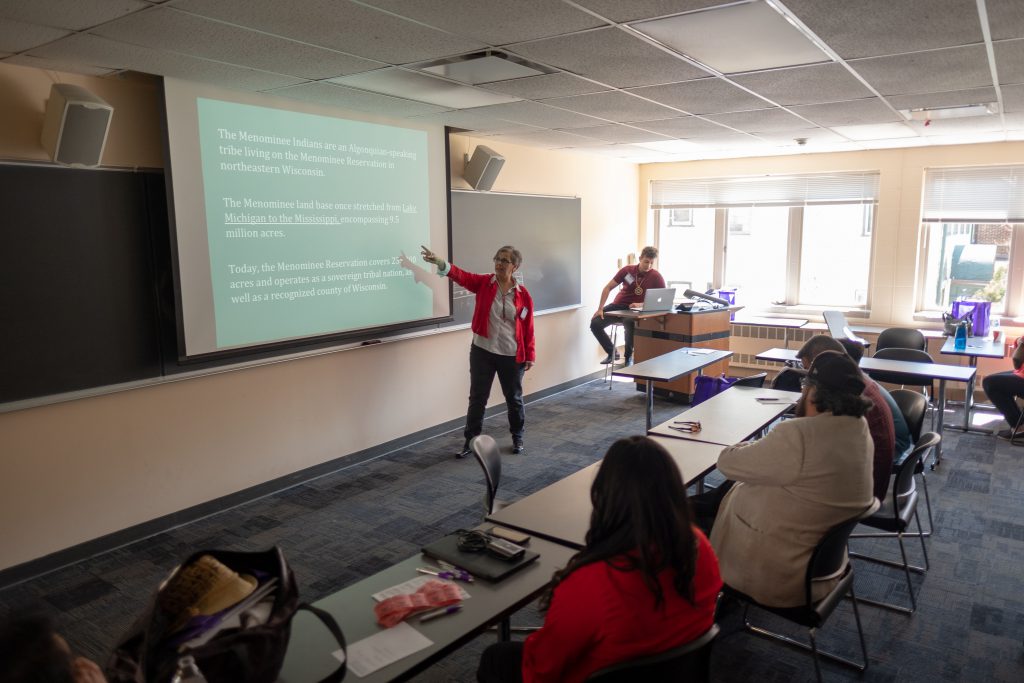By Lily Qi
Medill Reports
Pamala Silas used to hold annual meetings in downtown Chicago with other Menominee tribal members who lived in the area.
“I could get a hundred people to come to a meeting two times a year. I gave them a nice dinner, we had a presentation, the tribal leaders would come, we gave little gifts,” says Silas, who lives in Avondale.
Now meetings are no longer all downtown, with smaller breakfast meetings hosted in the suburbs as well.
“People have moved to many different places and it’s hard to have an event where everybody can come to because people are not going to drive an hour into Chicago for an hour-and-a-half meeting,” says Silas, while showing the address map she made of Chicago Menominee members. “So the best way I can organize is social media.”

With a Facebook group of 78, Silas and her co-coordinator Jayne Blacker developed a new way to communicate constantly with Menominee members who live in and around Chicago as well as with people living on the reservation in Wisconsin. Half of the members in the group live on the reservation, including elders and the current tribal chairman. But kinship and sharing are the themes everyone in the group holds dear and social media became a way to bridging the gap of across the distances.
“Social media is an affordable platform for staying in touch,” says Silas. “You can actually engage with members in a two-way communication and you can also get a sense of what the life experience of your members are so that you can design programs and service that meet their needs.”

The latest event held by the Menominee Community Center of Chicago was a Christmas potluck party which over 60 members attended. The center got RSVPs soon after posting it on the Facebook page. Participants exchanged gifts and shared their personal news with others. Total cost of the night was only about $150, a small fortune for the center but a great gathering, according to Silas.
Founded in 1994, the community center is only recognized off-reservation community entity in the Menominee nation. The community receives annual activity funding from the tribal government. Posts on social media also becomes a fund-raising approach.
“If I [drive] up there and I get in front of the all these people and I say I want $5,000 to run our club in Chicago, they’re like ‘we don’t know anybody there. That’s not our reservation’” says Silas. “But now they see that we had a gathering, they see the faces, they know we exist and they know that we’re still Menominees.”

With the 1956 Indian Relocation Act, many Native Americans Indians left reservations and that resulted in an increase in urban Native populations. A lot of them lost not only actual connections with families and friends on the reservation but also the cultural bonds with their tribes during the period. Many urban Indians knew about their own tribes only through local native cultural centers and events, with few visits to their homeland.
Social media changed all that, Blacker says. “Now because online connections are stronger, it’s not just the three visits a year [to the reservation]. We can communicate online almost instantly.”
Social media also allows tribes to serve members outside of the reservation. Lots of tribal news and organizations have their own Facebook pages and are active on platforms such as Twitter and Instagram. For those who grew up and live in the cities, social media keeps them informed.
“I joined the Menominee tribal school’s Facebook page to learn about what’s going on at the school,” says Jasmine Gurneau, a member of the Oneida tribe and a mother of two living in Avondale . Silas, her mother, is of Oneida as well as Menominee descent. “Sometimes the school does fun activities with the kids like maple tree tapping or wild rice harvesting.”
Even though Gurneau gets newspaper delivery from the Oneida, she still finds Facebook a useful platform to keep up with events and causes relevant to her native people. She followed the conflict between Native American Nathan Philips and Covington Catholic students and reactions within Native communities. A few weeks ago, she took her daughter to a puppet festival show about an Ojibwe intertribal story she found through Facebook. Gurneau’s husband is Ojibwe.
“My daughter learned about her values and there is some language embedded in there and the story was about using your values and the songs that you learn and your medicines,” says Gurneau. “She was able to see her first play that teaches those values.”
The latest communication technologies mean today’s urban Indians are linked closer to their own cultures that cross hundreds and, often, thousands of years.
“She connects in relationships with people,” says Silas when talking about how social media affects her daughter and grandchildren. “She knows more about her tribe now than she could 20 years ago.”

